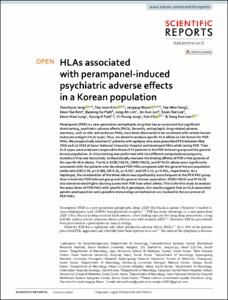HLAs associated with perampanel-induced psychiatric adverse effects in a Korean population
- Keimyung Author(s)
- Kim, Keun Tae
- Department
- Dept. of Neurology (신경과학)
- Journal Title
- Scientific Reports
- Issued Date
- 2020
- Volume
- 10
- Issue
- 1
- Abstract
- Perampanel (PER) is a new-generation antiepileptic drug that has an occasional but significant shortcoming, psychiatric adverse effects (PAEs). Recently, antiepileptic drug-related adverse reactions, such as skin rash and even PAEs, have been discovered to be correlated with certain human leukocyte antigen (HLA) types. Thus, we aimed to analyze specific HLA alleles as risk factors for PER-PAEs. We prospectively enrolled 17 patients with epilepsy who were prescribed PER between May 2016 and Jul 2018 at Seoul National University Hospital and developed PAEs while taking PER. Their HLA types were analyzed compared to those of 19 patients in the PAE-tolerant group and the general Korean population. In silico docking was performed with two different computational programs, AutoDock Vina and SwissDock, to theoretically evaluate the binding affinity of PER in the grooves of the specific HLA alleles. The HLA-DQB1*06: 01, DRB1*08: 03, and B*54: 01 alleles were significantly associated with the patients who developed PER-PAEs compared with the general Korean population (odds ratio [OR] 3.94, p = 0.008, OR 9.24, p = 0.037, and OR 3.25, p = 0.041, respectively). As a haplotype, the combination of the three alleles was significantly more frequent in the PER-PAE group than in both the PER-tolerant group and the general Korean population. DQB1*06: 01 and B*54: 01 also demonstrated higher docking scores with PER than other alleles. This is the first study to analyze the association of PER-PAEs with specific HLA genotypes. Our results suggest that an HLA-associated genetic predisposition and a possible immunological mechanism are involved in the occurrence of PER-PAEs.
- Keimyung Author(s)(Kor)
- 김근태
- Publisher
- School of Medicine (의과대학)
- Citation
- Yoonhyuk Jang et al. (2020). HLAs associated with perampanel-induced psychiatric adverse effects in a Korean population. Scientific Reports, 10(1), 13667. doi: 10.1038/s41598-020-70601-1
- Type
- Article
- ISSN
- 2045-2322
- Source
- https://www.nature.com/articles/s41598-020-70601-1
- Appears in Collections:
- 1. School of Medicine (의과대학) > Dept. of Neurology (신경과학)
- 파일 목록
-
-
Download
 oak-2020-0554.pdf
기타 데이터 / 1.04 MB / Adobe PDF
oak-2020-0554.pdf
기타 데이터 / 1.04 MB / Adobe PDF
-
Items in Repository are protected by copyright, with all rights reserved, unless otherwise indicated.